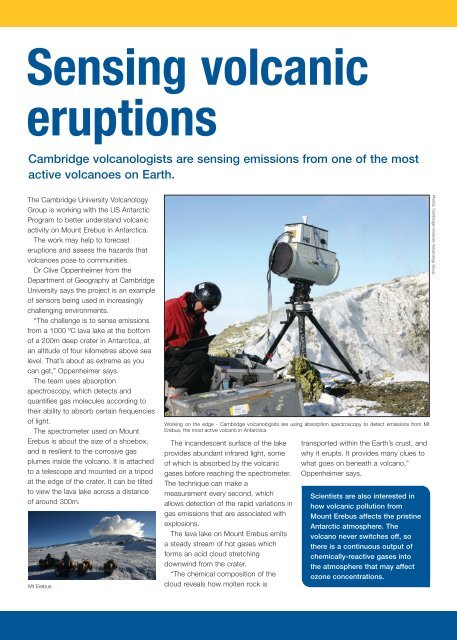Sensors News - Materials Science Institute of Madrid
Sensors News - Materials Science Institute of Madrid
Sensors News - Materials Science Institute of Madrid
Create successful ePaper yourself
Turn your PDF publications into a flip-book with our unique Google optimized e-Paper software.
Sensing volcanic<br />
eruptions<br />
Cambridge volcanologists are sensing emissions from one <strong>of</strong> the most<br />
active volcanoes on Earth.<br />
The Cambridge University Volcanology<br />
Group is working with the US Antarctic<br />
Program to better understand volcanic<br />
activity on Mount Erebus in Antarctica.<br />
The work may help to forecast<br />
eruptions and assess the hazards that<br />
volcanoes pose to communities.<br />
Dr Clive Oppenheimer from the<br />
Department <strong>of</strong> Geography at Cambridge<br />
University says the project is an example<br />
<strong>of</strong> sensors being used in increasingly<br />
challenging environments.<br />
“The challenge is to sense emissions<br />
from a 1000 ºC lava lake at the bottom<br />
<strong>of</strong> a 200m deep crater in Antarctica, at<br />
an altitude <strong>of</strong> four kilometres above sea<br />
level. That’s about as extreme as you<br />
can get,” Oppenheimer says.<br />
The team uses absorption<br />
spectroscopy, which detects and<br />
quantifies gas molecules according to<br />
their ability to absorb certain frequencies<br />
<strong>of</strong> light.<br />
The spectrometer used on Mount<br />
Erebus is about the size <strong>of</strong> a shoebox,<br />
and is resilient to the corrosive gas<br />
plumes inside the volcano. It is attached<br />
to a telescope and mounted on a tripod<br />
at the edge <strong>of</strong> the crater. It can be tilted<br />
to view the lava lake across a distance<br />
<strong>of</strong> around 300m.<br />
Mt Erebus<br />
Working on the edge - Cambridge volcanologists are using absorption spectroscopy to detect emissions from Mt<br />
Erebus, the most active volcano in Antarctica<br />
The incandescent surface <strong>of</strong> the lake<br />
provides abundant infrared light, some<br />
<strong>of</strong> which is absorbed by the volcanic<br />
gases before reaching the spectrometer.<br />
The technique can make a<br />
measurement every second, which<br />
allows detection <strong>of</strong> the rapid variations in<br />
gas emissions that are associated with<br />
explosions.<br />
The lava lake on Mount Erebus emits<br />
a steady stream <strong>of</strong> hot gases which<br />
forms an acid cloud stretching<br />
downwind from the crater.<br />
“The chemical composition <strong>of</strong> the<br />
cloud reveals how molten rock is<br />
transported within the Earth’s crust, and<br />
why it erupts. It provides many clues to<br />
what goes on beneath a volcano,”<br />
Oppenheimer says.<br />
Scientists are also interested in<br />
how volcanic pollution from<br />
Mount Erebus affects the pristine<br />
Antarctic atmosphere. The<br />
volcano never switches <strong>of</strong>f, so<br />
there is a continuous output <strong>of</strong><br />
chemically-reactive gases into<br />
the atmosphere that may affect<br />
ozone concentrations.<br />
Photos: Cambridge University Volcanology Group
















